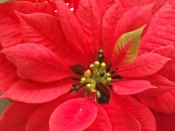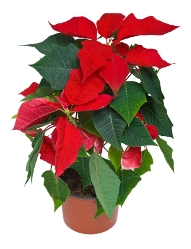





Botanical Name: Euphorbia pulcherrima
Good poinsettia care will keep your plant beautiful right through the holidays.

Bright and cheery, poinsettia is a traditional decoration at Christmas time.
Its "flowers" are actually leaf-like bracts that surround the tiny, yellow true flowers in the center. Red still rules, but newer cultivars are available in burgundy, white, peach or pink -- some marbled or flecked. They also range from palm-sized miniatures to giant floor plants with bigger bracts than we've ever seen.
Poinsettia grows best in bright light, but too much direct sun can cause bract color to fade. It doesn't like cold drafts either. Exposing it to temperatures below 50°F/10°C can cause its leaves to drop.
Most poinsettias are tossed out after the holidays, or after the bracts have faded. However, with some effort and these poinsettia care tips, you can coax your poinsettia back into bloom before next Christmas.

Origin: Mexico
Height: Varies from 6 in (15 cm) miniatures to 36 in (90 cm) tall, full plants
Light: Bright light. Direct sun can cause bract color to fade.
Water: Water thoroughly, then allow top of soil to dry out between waterings. Remove the decorative foil to allow good drainage. This plant is prone to root rot if soil is too soggy.
Humidity: Average room humidity.
Temperature: Average room temperatures 60-75°F/15-24°C
Soil: Any good potting mix.
Fertilizer: Not usually necessary, but if the poinsettia is kept for another season it will benefit from a high-phosphorus fertilizer diluted by half every 2 weeks.
Propagation: Take 3 in (7.5 cm) stem tip cuttings when new growth starts in spring or early summer. Cuttings will ooze a milky sap that can be stopped by placing the cut end in water before potting it. Contrary to popular belief, poinsettia sap is not poisonous, but it may cause skin irritation.
Copyright © www.100flowers.win Botanic Garden All Rights Reserved